ADDICTION
ALCOHOL DEPENDENCE
QUIT SMOKING
ALLERGY
ANTI FUNGAL
FUNGAL INFECTION
FUNGAL NAIL INFECTIONS
ANTI-REJECTION DRUGS
ANTI WORM
ANTIBIOTIC
BACTERIAL INFECTIONS
ARTHRITIS
GOUT
OSTEOARTHRITIS
RHEUMATOID ARTHRITIS
BLOOD
LOW PLATELET COUNT
THROMBOPHLEBITIS
VARICOSE VEINS
COLON
ANAL FISSURE
PILES
ULCERATIVE COLITIS
DIABETES CARE
DIABETES INSIPIDUS
DIABETES TYPE
DIABETIC FOOT ULCERS
GLUCOSE MONITOR
EYES/EAR CARE
DRY EYES
EYE CARE
EYE EXAMINATION
EYE INFECTION
EYE LASHES
EYE PAIN
GLAUCOMA
OCULAR HYPERTENSION
UVEITIS
FEVER CARE
MALARIA
RHEUMATIC FEVER
TYPHOID FEVER
GASTROINTESTINAL
ACIDITY
CONSTIPATION
CROHN'S DISEASE
DIARRHOEA
GALLBLADDER STONES
INTESTINAL ULCERS
IRRITABLE BOWEL SYNDROME
MOTION SICKNESS
NAUSEA
Hansepran 100 mg (Clofazimine)
| Active Ingredient (Generic Name): | Clofazimine |
|---|---|
| Indication: | Leprosy |
| Manufacturer: | Abbott India Pvt Ltd |
| Packaging: | 10 capsules in one strip |
| Strength: | 100 mg |
From: $43.00
Hansepran 100 Mg, a capsule containing clofazimine, is a riminophenazine-class drug used to treat leprosy (Hansen’s disease). Clofazimine inhibits bacterial growth by binding to bacterial DNA, exhibits anti-inflammatory effects, and prevents bacterial multiplication. This medication manages symptoms and prevents nerve damage, but it is not a cure. To minimize gastrointestinal side effects, take Hansepran 100 Mg with food. Understanding the correct dosing, potential side effects, and interactions with other medications is crucial for effective treatment.
Main Points
Hansepran 100 Mg contains clofazimine, a riminophenazine class drug used to treat leprosy (Hansen’s disease) and manage its symptoms.
Clofazimine inhibits bacterial growth by binding to bacterial DNA and disrupting replication, and has anti-inflammatory effects.
The medication is taken orally with food to minimize gastrointestinal side effects. Dosage varies based on individual factors, typically one to two times daily.
Common side effects include gastrointestinal issues, dermatological reactions, headaches, and fatigue. Severe reactions like allergies or blood disorders are rare.
Hansepran 100 Mg has interactions with other medications. Inform your doctor about all current medications to avoid adverse reactions.
What Is Hansepran 100 Mg?
Hansepran 100 Mg is a medication containing the active pharmaceutical ingredient clofazimine, which belongs to the riminophenazine class of drugs. It is used to treat leprosy, also known as Hansen’s disease, a chronic bacterial infection affecting the nerves, skin, and mucous membranes.
This oral medication is available in 100 mg capsules and is typically taken with food to minimize gastrointestinal side effects. Hansepran 100 Mg is not a cure for leprosy but rather a treatment to manage symptoms and prevent further nerve damage. It works by inhibiting the growth of the Mycobacterium leprae bacterium, which causes the infection.
Hansepran 100 Mg may be prescribed as part of a combination therapy, along with other antibiotics, to ensure effective treatment. It is essential to take the medication exactly as directed and to complete the full treatment course to prevent relapse.
How Does Clofazimine Work?
Clofazimine’s mechanism of action is rooted in its ability to inhibit bacterial growth. It also exhibits anti-inflammatory effects, reducing swelling and pain. Additionally, its bacteriostatic properties prevent the growth of bacteria without killing them.
Mechanism of Action
Hansepran 100 mg’s active ingredient, clofazimine, inhibits the growth of Mycobacterium leprae, the bacterium responsible for leprosy, by binding to bacterial DNA. This binding ability disrupts DNA replication, ultimately preventing the growth and proliferation of Mycobacterium leprae.
The mechanism of action is as follows:
| Mechanism | Effect | Impact on Bacteria |
|---|---|---|
| DNA binding | Inhibits DNA synthesis | Prevents replication |
| RNA synthesis inhibition | Reduces protein production | Disrupts growth |
| Protein synthesis inhibition | Reduces cell wall formation | Weakens cell structure |
| Membrane function disruption | Increases membrane permeability | Allows content leakage |
| ATP production inhibition | Reduces energy production | Slows metabolism |
Note: The table provides a concise breakdown of clofazimine’s mechanism of action in inhibiting Mycobacterium leprae growth.
Anti-Inflammatory Effects
Clofazimine’s anti-inflammatory effects are crucial to its therapeutic action. It inhibits the production of pro-inflammatory cytokines, which contribute to the inflammatory response in leprosy. Leprosy is characterized by chronic inflammation, which can lead to nerve damage and discoloration.
Clofazimine achieves its anti-inflammatory effect through:
- Inhibiting the activity of inflammatory enzymes, including lipoxygenase and cyclooxygenase, which produce pro-inflammatory mediators.
- Suppressing the production of inflammatory cytokines, including tumor necrosis factor-alpha (TNF-alpha) and interleukin-1 beta (IL-1?).
- Reducing the expression of adhesion molecules, which are involved in the recruitment of immune cells to the site of inflammation.
Bacteriostatic Properties
Clofazimine inhibits the synthesis of mycolic acid, an essential component of the mycobacterial cell wall. This prevents the multiplication of Mycobacterium leprae, thereby halting the progression of leprosy. By blocking mycolic acid production, clofazimine disrupts the formation of the mycobacterial cell wall, inhibiting bacterial growth.
Clofazimine’s mechanism of action makes it effective in managing leprosy, a chronic and debilitating bacterial infection. Its bacteriostatic properties are particularly useful in treating multibacillary leprosy, where the bacterial load is high. By preventing Mycobacterium leprae multiplication, clofazimine reduces symptom severity and prevents long-term nerve damage.
Uses of Clofazimine
Clofazimine is used to treat leprosy, a chronic bacterial infection that affects the nerves, skin, and mucous membranes. It is essential in managing leprosy symptoms, which can lead to severe disability and disfigurement if left untreated.
Clofazimine also treats skin conditions, including dermatitis, psoriasis, and eczema.
Research has explored clofazimine’s potential in treating tuberculosis and Crohn’s disease due to its unique mechanism of action and bacteriostatic properties, making it a valuable medication in treating bacterial infections.
Dosage and Administration
When taking Hansepran 100 Mg (Clofazimine), adhere to the recommended dosage to ensure effective treatment and minimize potential side effects. The ideal dosage varies depending on individual factors such as age, weight, and health conditions. Follow the guidelines to maximize the benefits of this medication while reducing the risk of adverse reactions.
Dosage Recommendations
To achieve optimal treatment outcomes, adhere to the dosage recommendations when taking Hansepran 100 mg (Clofazimine) orally, typically one to two times daily, depending on the specific condition being treated and the patient’s response to therapy. The dosage may be adjusted by your doctor based on individual needs and medical history.
When using Hansepran 100 mg, careful adherence to dosage recommendations is crucial for optimal treatment results. Key considerations include:
- Initial dosing: Start with a lower dose and increase as needed and under medical supervision.
- Progress monitoring: Regularly track symptoms and report any changes to your doctor to adjust the dosage accordingly.
- Consistency: Take Hansepran 100 mg at the same time every day to maintain a consistent level of the medication in your system.
Administration Guidelines
To ensure proper administration, follow the specific dosage and administration guidelines outlined by your doctor or printed on the prescription label. This ensures correct use of Hansepran 100 mg (Clofazimine) and minimizes the risk of adverse effects. Take the capsules orally, with or without food, as directed by your doctor. Swallow the capsules whole; do not crush, break, or chew them, as this can affect the medication’s absorption.
Take Hansepran 100 mg at the same time every day, with a full glass of water. This maintains consistent levels of the medication in your system. Do not skip doses or stop taking the medication without consulting your doctor, as this can lead to treatment failure or recurrence of symptoms. If you miss a dose, take it as soon as you remember, unless it’s close to the time for your next scheduled dose. In that case, skip the missed dose and continue with your regular dosing schedule.
Side Effects of Clofazimine
Clofazimine, a riminophenazine antibiotic, can cause various side effects. These effects may include:
- Gastrointestinal issues: nausea, vomiting, diarrhea, and abdominal pain.
- Dermatological reactions: skin discoloration, rash, and itching.
- Other effects: headaches, fatigue, and changes in appetite.
Report any side effects to your doctor, as they can help you manage these issues. In rare cases, clofazimine can cause severe reactions, such as allergic responses or blood disorders. If you experience unusual symptoms, seek medical attention promptly.
Interactions With Other Medications
When prescribed Hansepran 100 mg, it is crucial to inform your doctor about all medications you’re currently taking. Clofazimine can interact with various drugs, either increasing or decreasing their effects, or vice versa.
Avoid taking clofazimine with medications that can cause QT prolongation, such as certain antibiotics or antidepressants, as this can increase the risk of arrhythmias.
The following medications can interact with clofazimine:
| Medication | Interaction |
|---|---|
| Rifampicin | Decreased clofazimine levels, reducing its effectiveness |
| Ciprofloxacin | Increased risk of QT prolongation and arrhythmias |
| Antacids | Decreased clofazimine absorption, reducing its effectiveness |
| Phenytoin | Decreased clofazimine levels, reducing its effectiveness |
Discuss your medications with your doctor to ensure safe and effective treatment with Hansepran 100 mg.
Precautions and Contraindications
Precautions and Contraindications
When taking Hansepran 100 mg, certain precautions and contraindications must be considered to ensure safe and effective treatment.
Important Considerations:
-
Allergic reactions: Avoid Hansepran 100 mg if allergic to clofazimine or its components, as allergic reactions can be severe. Inform your doctor about any allergies before starting treatment.
-
Pregnancy and breastfeeding: Hansepran 100 mg is not recommended during pregnancy or breastfeeding, as its effects on the fetus or baby are unknown. Consult your doctor before taking the medication if pregnant, planning to become pregnant, or breastfeeding.
-
Skin discoloration: Clofazimine can cause skin discoloration, especially in fair-skinned individuals. Report any unusual skin changes to your doctor while taking Hansepran 100 mg.
Storage and Disposal Instructions
Hansepran 100 mg Storage and Disposal Instructions
To maintain its potency and shelf life, store Hansepran 100 mg in a cool, dry place away from direct sunlight and moisture. Keep it out of reach of children and pets.
Disposal Instructions:
Do not flush Hansepran 100 mg down the toilet or pour it into a drain unless instructed to do so. Instead, discard the medication when it is expired or no longer needed.
Storage Conditions:
- Cool, dry place
- Away from direct sunlight
- Away from moisture
- Out of reach of children and pets
Disposal Methods:
- Dispose of in a sealed container
- Return to a pharmacy or healthcare facility
- Check with local authorities for guidance
- Do not flush or pour down drain
- Follow local regulations
Follow the specific storage and disposal instructions provided by your pharmacist or healthcare professional. If you have questions or concerns, contact them for guidance.
Frequently Asked Questions
Can I Take Hansepran 100 Mg With Other Leprosy Medications?
Clofazimine, the active ingredient in Hansepran 100 mg, is typically used in combination with other antibacterial agents to treat leprosy. To determine the best treatment plan for your specific case, consult your doctor.
Is Hansepran 100 Mg Safe for Children and Pregnant Women?
The safety of Hansepran 100 mg has not been established for children and pregnant women. It is recommended to consult a doctor before use in these groups, as potential risks may outweigh benefits.
Can I Stop Taking Hansepran 100 Mg if I Feel Better?
Do not stop taking Hansepran 100 mg without consulting your doctor, even if symptoms improve. This medication is typically prescribed for a specific duration to ensure the infection is fully cleared.
How Long Does It Take for Hansepran 100 Mg to Start Working?
The effects of Hansepran 100 mg typically become apparent within 2-4 weeks of treatment. Maximum therapeutic effects may take 6-12 weeks to manifest as the medication reaches steady-state concentrations in the body.
Will Hansepran 100 Mg Affect My Ability to Drive or Operate Heavy Machinery?
When taking Hansepran 100 mg, caution is advised when driving or operating heavy machinery due to potential side effects of dizziness, lightheadedness, and blurred vision, which may impair safe performance of these tasks.
Conclusion
You have been prescribed Hansepran 100 mg, which contains clofazimine. To ensure effective treatment, carefully follow the dosage instructions and monitor your body’s response. Be aware of potential side effects and contraindications. This will help maximize the drug’s benefits while minimizing its risks.


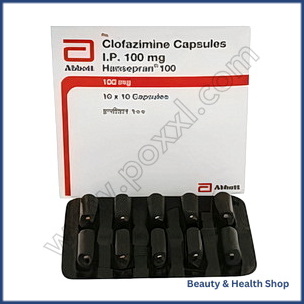
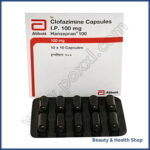

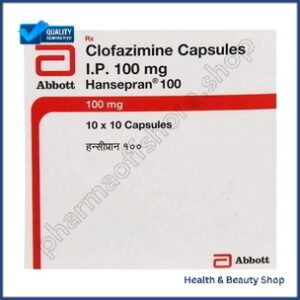
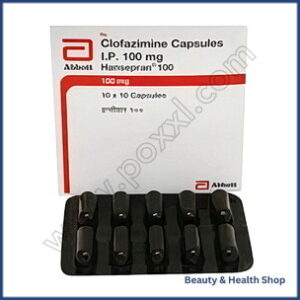
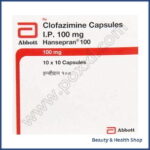
There are no reviews yet.